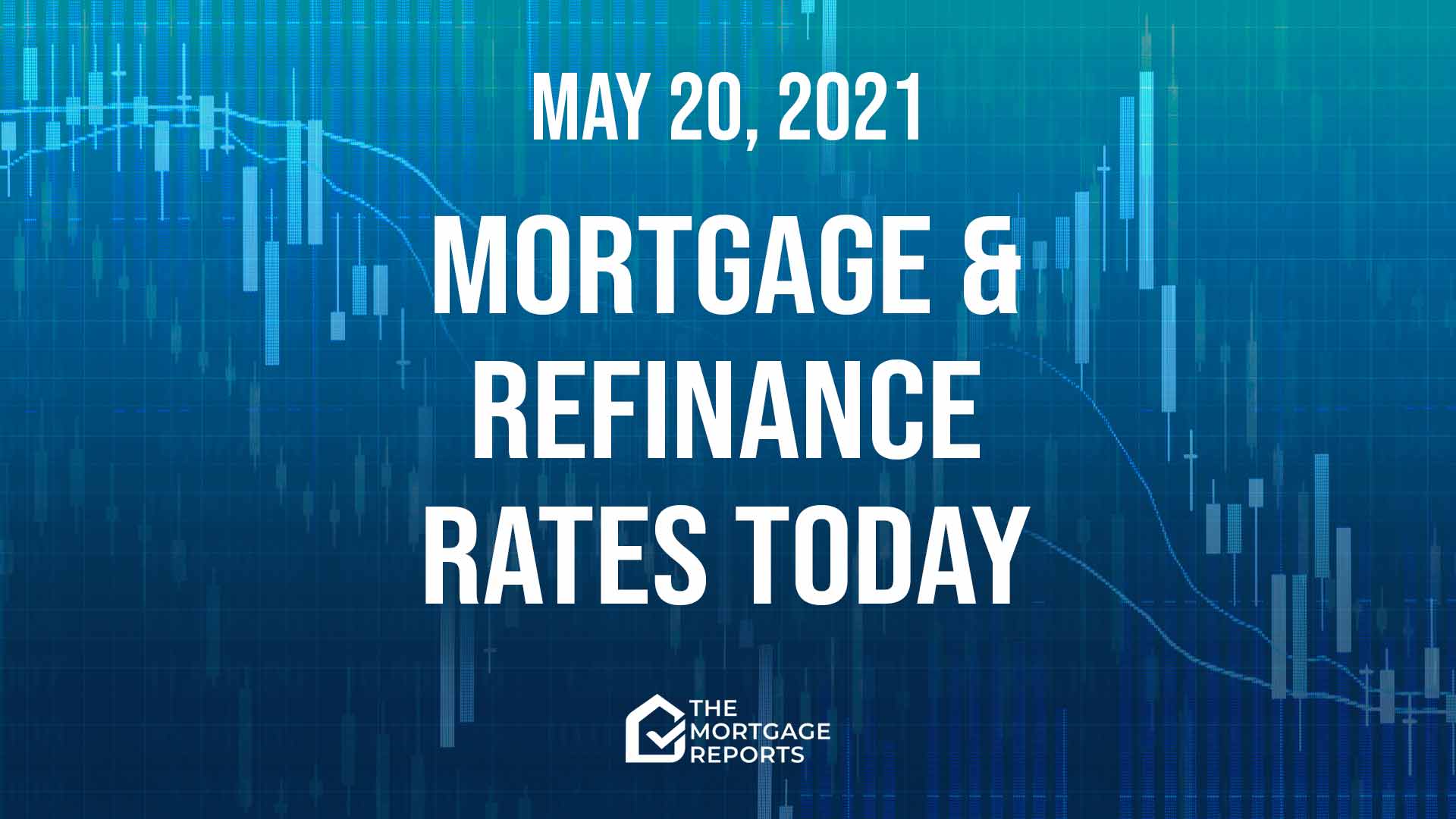
Today’s mortgage and refinance rates
Average mortgage rates nudged higher yesterday. That was only a bit of a surprise. Because I warned that morning that an afternoon Federal Reserve event might change things. And it did.
Key markets are pointing in different directions this morning. But mortgage rates aren’t looking likely to move far today.
Find and lock a low rate (May 24th, 2021)Current mortgage and refinance rates
| Program | Mortgage Rate | APR* | Change |
|---|---|---|---|
| Conventional 30 year fixed | |||
| Conventional 30 year fixed | 3.105% | 3.11% | +0.03% |
| Conventional 15 year fixed | |||
| Conventional 15 year fixed | 2.281% | 2.399% | +0.03% |
| Conventional 20 year fixed | |||
| Conventional 20 year fixed | 2.844% | 2.935% | +0.09% |
| Conventional 10 year fixed | |||
| Conventional 10 year fixed | 1.942% | 2.136% | +0.02% |
| 30 year fixed FHA | |||
| 30 year fixed FHA | 2.814% | 3.472% | Unchanged |
| 15 year fixed FHA | |||
| 15 year fixed FHA | 2.498% | 3.099% | -0.03% |
| 5 year ARM FHA | |||
| 5 year ARM FHA | 2.5% | 3.201% | Unchanged |
| 30 year fixed VA | |||
| 30 year fixed VA | 2.5% | 2.674% | +0.13% |
| 15 year fixed VA | |||
| 15 year fixed VA | 2.25% | 2.571% | Unchanged |
| 5 year ARM VA | |||
| 5 year ARM VA | 2.5% | 2.379% | Unchanged |
| Rates are provided by our partner network, and may not reflect the market. Your rate might be different. Click here for a personalized rate quote. See our rate assumptions here. | |||
COVID-19 mortgage updates: Mortgage lenders are changing rates and rules due to COVID-19. To see the latest on how coronavirus could impact your home loan, click here.
Should you lock a mortgage rate today?
The last 10 days have been grim for mortgage rates. And they’re currently at their highest levels in a month.
Of course, it’s too soon to be certain that we won’t have another period of falls sometime soon. But there’s little reason to expect one that’s going to drag rates significantly lower.
So my personal rate lock recommendations remain:
- LOCK if closing in 7 days
- LOCK if closing in 15 days
- LOCK if closing in 30 days
- LOCK if closing in 45 days
- LOCK if closing in 60 days
However, I don’t claim perfect foresight. And your personal analysis could turn out to be as good as mine — or better. So you might choose to be guided by your instincts and your personal tolerance for risk.
Market data affecting today’s mortgage rates
Here’s a snapshot of the state of play this morning at about 9:50 a.m. (ET). The data, compared with roughly the same time yesterday, were:
- The yield on 10-year Treasurys held steady at 1.65% (Neutral for mortgage rates.) More than any other market, mortgage rates normally tend to follow these particular Treasury bond yields, though less so recently
- Major stock indexes were a little higher on opening. (Bad for mortgage rates.) When investors are buying shares they’re often selling bonds, which pushes prices of those down and increases yields and mortgage rates. The opposite may happen when indexes are lower
- Oil prices fell to $62.84 from $63.26 a barrel. (Good for mortgage rates*.) Energy prices play a large role in creating inflation and also point to future economic activity.
- Gold prices inched down to $1,875 from $1,885 an ounce. (Neutral for mortgage rates*.) In general, it’s better for rates when gold rises, and worse when gold falls. Gold tends to rise when investors worry about the economy. And worried investors tend to push rates lower
- CNN Business Fear & Greed index — rose to 35 from 30 out of 100. (Bad for mortgage rates.) “Greedy” investors push bond prices down (and interest rates up) as they leave the bond market and move into stocks, while “fearful” investors do the opposite. So lower readings are better than higher ones
Caveats about markets and rates
Before the pandemic and the Federal Reserve’s interventions in the mortgage market, you could look at the above figures and make a pretty good guess about what would happen to mortgage rates that day. But that’s no longer the case. We still make daily calls. And are usually right. But our record for accuracy won’t achieve its former high levels until things settle down.
So use markets only as a rough guide. Because they have to be exceptionally strong or weak to rely on them. But, with that caveat, so far mortgage rates today look likely to barely move. However, be aware that intraday swings (when rates change direction during the day) are a common feature right now.
Find and lock a low rate (May 24th, 2021)
Important notes on today’s mortgage rates
Here are some things you need to know:
- Typically, mortgage rates go up when the economy’s doing well and down when it’s in trouble. But there are exceptions. Read ‘How mortgage rates are determined and why you should care
- Only “top-tier” borrowers (with stellar credit scores, big down payments and very healthy finances) get the ultralow mortgage rates you’ll see advertised
- Lenders vary. Yours may or may not follow the crowd when it comes to daily rate movements — though they all usually follow the wider trend over time
- When daily rate changes are small, some lenders will adjust closing costs and leave their rate cards the same
- Refinance rates are typically close to those for purchases. But some types of refinances are higher following a regulatory change
So there’s a lot going on here. And nobody can claim to know with certainty what’s going to happen to mortgage rates in coming hours, days, weeks, or months.
Are mortgage and refinance rates rising or falling?
Today and soon
So what was the Fed event that prompted yesterday’s rise in mortgage rates? It was the publication of the minutes of its last key policy meeting: that of the Federal Open Market Committee or FOMC.
The headline news was good. And the recovery is still on course, perhaps heading into a boom. But there was also less welcome news for markets. The New York Times reported:
But the minutes also noted that a “number” of officials said that “if the economy continued to make rapid progress toward the committee’s goals, it might be appropriate at some point in upcoming meetings to begin discussing a plan for adjusting the pace of asset purchases.” The line was among the clearest signals yet that some Fed officials had considered beginning a serious conversation about pulling back monetary help.
— NYT, “Fed Officials Hinted They Might Soon Talk About Slowing Bond-Buying,” (Paywall) May 19, 2021
Let’s unpack that a bit. At the moment, the Fed is spending roughly $120 billion each month on asset purchases. Those are mostly bonds, including mortgage-backed securities (MBSs). And it’s the prices of those MBSs that actually determine mortgage rates.
Mortgage rates now artificially low
In other words, the Fed has been keeping mortgage rates artificially low by topping up demand for MBSs that some regular investors don’t want. And, if it stops, those rates are likely to rise.
Indeed, even the Fed thinking about stopping can be enough to drive mortgage rates higher. Because private-sector investors think that higher rates and yields are probably on their way. And why would they want to be stuck with a lower, fixed yield on an MBS for up to 30 years when they could get a higher one just by waiting for a while?
Of course, all this is tied up with a fear of future inflation. And that’s something we’ve explored recently.
Mortgage rates and inflation: Why are rates going up?
True, there’s nothing certain in economics. And it’s always possible that some cataclysmic event will arise that will reverse the recovery and consistently push down mortgage rates again. Possible but, I suspect, unlikely.
For more background, check out our latest weekend edition of this report.
Recently — Updated today
Over much of 2020, the overall trend for mortgage rates was clearly downward. And a new, weekly all-time low was set on 16 occasions last year, according to Freddie Mac.
The most recent weekly record low occurred on Jan. 7, when it stood at 2.65% for 30-year fixed-rate mortgages. But then the trend reversed and rates rose.
However, those rises were mostly replaced by falls in April, though those moderated during the second half of that month. And May has so far seen rises outweighing falls. Freddie’s May 20 report puts that weekly average at 3.0% (with 0.6 fees and points), up from the previous week’s 2.94%.
Expert mortgage rate forecasts
Looking further ahead, Fannie Mae, Freddie Mac and the Mortgage Bankers Association (MBA) each has a team of economists dedicated to monitoring and forecasting what will happen to the economy, the housing sector and mortgage rates.
And here are their current rates forecasts for the remaining quarters of 2021 (Q2/21, Q3/21, Q4/21) and the first quarter of 2022 (Q1/22).
The numbers in the table below are for 30-year, fixed-rate mortgages. Fannie’s were updated on May 19 and the MBA’s on April 22. Freddie’s forecast is dated April 14. But it now updates only quarterly. So expect its numbers to begin to look stale soon.
| Forecaster | Q2/21 | Q3/21 | Q4/21 | Q1/22 |
| Fannie Mae | 3.0% | 3.1% | 3.2% | 3.3% |
| Freddie Mac | 3.2% | 3.3% | 3.4% | 3.5% |
| MBA | 3.4% | 3.6% | 3.7% | 3.9% |
However, given so many unknowables, the current crop of forecasts might be even more speculative than usual.
Find your lowest rate today
Some lenders have been spooked by the pandemic. And they’re restricting their offerings to just the most vanilla-flavored mortgages and refinances.
But others remain brave. And you can still probably find the cash-out refinance, investment mortgage or jumbo loan you want. You just have to shop around more widely.
But, of course, you should be comparison shopping widely, no matter what sort of mortgage you want. As federal regulator the Consumer Financial Protection Bureau says:
Verify your new rate (May 24th, 2021)Shopping around for your mortgage has the potential to lead to real savings. It may not sound like much, but saving even a quarter of a point in interest on your mortgage saves you thousands of dollars over the life of your loan.



